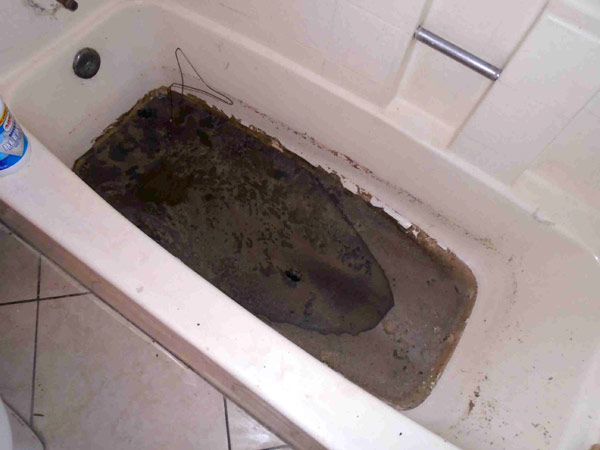Have you been hunting for help and advice on Why is Sewage Backing Up Into My Bathtub??

Sewage backup in the bathtub can be an upsetting and unhygienic issue for any kind of home owner. Not just is it troublesome, yet it additionally presents serious health and wellness threats and suggests underlying concerns with the plumbing system. Comprehending why sewage is turning up through the bath tub is critical for taking proper action to address the trouble properly.
Introduction to the Concern
Usual Factors for Sewage Backup
Clogs in the Sewage System Line
Among one of the most typical reasons for sewage back-up is a clog in the drain line. This can happen due to the accumulation of debris, grease, or international things in the pipelines, avoiding proper circulation and triggering sewage to support into your bathtub.
Tree Root Breach
Tree roots seeking wetness and nutrients can penetrate sewer lines through little fractures or joints. Over time, these roots can grow and expand, creating substantial damage to the pipes and resulting in sewage back-up concerns.
Understanding the Issue
When sewer starts backing up right into the bath tub, it's a clear indication of an issue with the drainage system. The wastewater that ought to be moving away from your home is instead locating its back right into your space, which can result in considerable damages and carcinogen.
Prospective Reasons
Several variables can add to sewer back-up in the bath tub. From obstructions in the sewage system line to issues with the plumbing framework, determining the origin is crucial for discovering a solution.
Aging Framework
Older homes may have outdated plumbing systems that are much more at risk to corrosion, splits, and damage. As pipelines age, they end up being much more vulnerable to leaks and blockages, increasing the likelihood of sewer backup occurrences.
Heavy Rainfall or Flooding
During durations of heavy rainfall or flooding, the drain system might come to be overloaded with excess water, triggering backups and overflows. This can result in sewage backing up right into bath tubs and other components inside the home.
Signs of Sewage Backup
Foul Odors
Unpleasant smells emanating from drains pipes or components, particularly in the shower room, might suggest sewer backup problems. These smells are often solid and relentless, indicating a problem that calls for prompt interest.
Slow Draining Fixtures
Bath tubs, sinks, and toilets that drain pipes slowly or not at all could be experiencing sewer backup. If multiple fixtures are affected concurrently, it's likely that the concern originates from a common factor, such as the major drain line.
Gurgling Sounds
Strange gurgling or bubbling noises originating from drains pipes when water is running in other places in your house are a measure of air caught in the plumbing system. This air accumulation can result from sewage backup and must be explored quickly.
Health Dangers Related To Sewage Back-up
Contamination of Water Supply
Sewer back-up can infect the water in your home, posing a major wellness danger to you and your family members. Direct exposure to infected water can cause stomach concerns, skin infections, and various other diseases.
Mold Development
Dampness from sewage backup can create perfect problems for mold and mildew development in your house. Mold and mildew spores can aggravate respiratory issues and cause allergic reactions in delicate individuals, making prompt clean-up important.
Spread of Illness
Sewer has hazardous bacteria, infections, and bloodsuckers that can cause a series of conditions, consisting of hepatitis, cholera, and gastroenteritis. Entering into contact with sewer or contaminated surfaces puts you in jeopardy of infection.
Cleaning Up After Sewage Backup
Disinfection Procedures
Completely sanitize and sanitize influenced areas after sewage backup to remove harmful germs and protect against mold and mildew growth. Usage suitable cleaning items and protective equipment to guarantee safe and effective cleanup.
Restoration of Impacted Areas
Repair any kind of damages to floor covering, walls, or components caused by sewer backup. Relying on the extent of the damage, you may require to change carpeting, drywall, or various other materials to restore your home to its pre-loss problem.
Immediate Actions to Take
Turning Off Water System
In case of sewer backup, it's important to turn off the water to avoid further contamination and damage. Locate the primary water shutoff valve in your house and closed it off up until the issue can be settled.
Speaking To a Specialist Plumber
Managing sewage back-up is not a do it yourself task. Call a qualified plumber with experience in managing sewage-related problems to assess the situation and carry out required repair work or clean-ups.
Preventing Contact with Contaminated Water
Up until the sewage backup is fixed, prevent contact with polluted water to stop the spread of bacteria and virus. Put on protective gear if you must be in the damaged location and wash your hands extensively afterward.
Safety nets
Routine Maintenance of Drain Lines
Arrange normal evaluations and upkeep of your sewage system lines to recognize and attend to possible concerns prior to they rise right into significant problems. This can include cleaning out particles, inspecting for tree origin intrusion, and fixing any kind of broken pipelines.
Setting Up Backwater Shutoffs
Take into consideration mounting backwater shutoffs in your plumbing system to stop sewer from flowing back into your home during periods of heavy rainfall or flooding. These shutoffs immediately close when water starts backing up, safeguarding your home from contamination.
Appropriate Disposal of Family Waste
Prevent flushing anything apart from bathroom tissue and human waste down the bathroom to prevent blockages and obstructions in the drain line. Dispose of grease, oil, and various other home chemicals correctly to lessen the risk of plumbing problems.
Why Is Water Backing Up in My Bathtub When I Flush My Toilet?
What to do about a sewer line clog
First, don’t bother with plunging. No amount of plunging will dislodge the clog in a sewer line. The clog is too far away. Plungers are for clogs in the toilet itself, not the sewer line. Plus, the most likely causes of a sewer clog are:
Tree roots Flushed toys or feminine products Grease buildup Those items don’t move easily. And in the case of tree roots, the roots need to be cut out of the pipe and the pipe will need to be repaired.
You’ll need a closet auger. A closet auger is a type of plumber’s snake with a protective cover to keep from scratching the delicate porcelain toilet. If the clog is further down, you may need to remove the toilet or use one of your cleanouts to get to the clog.
We also recommend doing a video inspection of the drain to ensure that the cause of the clog has been completely removed. Otherwise, you could have the same problem again in a few days or weeks.
https://mspplumbingheatingair.com/blog/why-is-water-backing-up-in-my-bathtub-when-i-flush-my-toilet

Hopefully you enjoyed reading our topic about Why is Sewage Backing Up Into My Bathtub?. Thanks so much for taking time to browse our piece of content. Be sure to set aside a second to promote this blog entry if you enjoyed reading it. Thank-you for taking the time to read it.
Schedule An Appointment